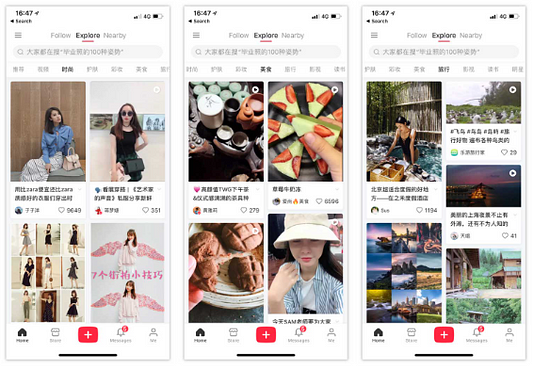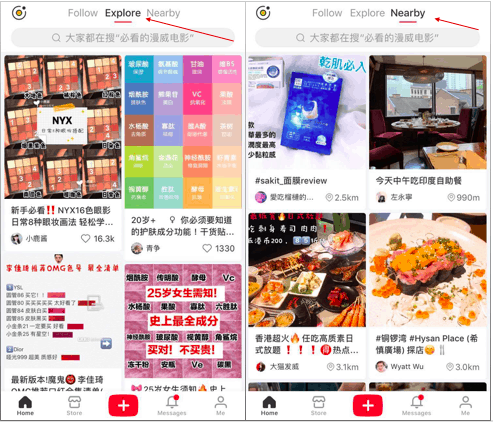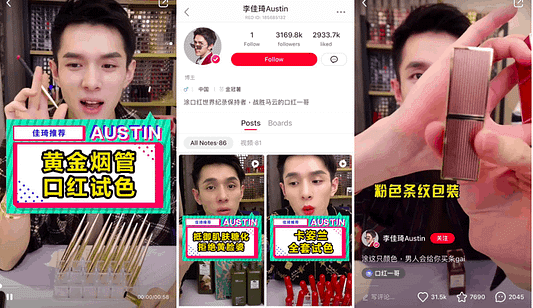It’s no secret that China has its own version of almost every mainstream Western app. We’re sure you’ve heard of some of them like WeChat, Baidu, and Weibo.
But are you familiar with the “Chinese Instagram”?
It’s called the Little Red Book, and it’s wildly popular.
For this reason, we decided to introduce you to this app.
And since we’re all about marketing, we’ll also take a deep dive into the Little Red Book marketing potential!
What is the Little Red Book (Xiaohongshu)?
In China, the Little Red Book platform goes by the name Xiaohongshu.
Yet, globally, it is often referred to as just “RED”.
Now that you’re aware of all of its names, let us point out the main things you should know about this app.
The Little Red Book was first launched in 2013 as a photo & video review platform. In it, Chinese travelers would recommend beauty products they purchased outside of Mainland China. It also had a fitting first slogan – “Finding stuff overseas”.
Soon, the platform became popular among people with no travel intent too.
For this reason, Red expanded its mission, features, and user base. Today, its slogan is “Marking your beautiful things”, which can apply to a lot of things.

Source: Xiaohongshu Youtube channel
The app is still mainly specialized in beauty and fashion. However, in the last couple of years, it positioned itself as more of a lifestyle app. Some popular content categories on Red include entertainment, home, games, pets, food, travel, education, culture, creativity, and parenting.
Looking for restaurant recommendations in another city? Try Xiaohongshu. Makeup tutorials? Xiaohongshu. Ideas on what to do when bored? Xiaohongshu. The best food for your cat? ” Xiaohongshu.
You get the gist.
Because of its versatility and features, people call it a hybrid of Instagram, Pinterest, Amazon, and even TripAdvisor.
How Does Red Work Exactly?

Source: WalkTheChat
One of the most impressive things about the Little Red book is how many different features it has.
This app is a combination of a social network and an e-commerce platform, powered by user-generated content (UGC).
How does all this blend together?
Here’s a quick guide through the in-app experience in Red.
The app consists of three different feeds:
- Explore
- Follow
- Nearby
When users open the app, the first thing they see is the “explore” feed. In it, they can see posts they might be interested in, based on their previous interactions and browsing history.
Unlike on Instagram, here, the homepage doesn’t include posts from the users they follow. If they want to see their content, users need to switch to a separate “follow” tab.

Source: Dragon Social
Finally, the “nearby” feed displays the latest posts from users who are close, sorted by distance. This feature is especially useful when traveling or looking for places to shop, eat or visit.
Main Features
Little Red Book’s user interface is similar to most other social apps. Its feed includes videos, live streams, images, descriptions, and hashtags.
But, when it comes to text, here – longer is better.
However, on Red, long text pieces are desirable and encouraged. Such posts are called “notes” and they bring lengthy, in-depth product reviews.
In these posts, users typically add a hyperlink to the brand’s app page, which usually contains a shopping section. This makes up for a smooth switch from the social to e-commerce segment of the app.
Finally, on the platform, users can interact with the content just like on most other social networks. They can like, comment, and save posts to their boards.
Little Red Book vs. Instagram
As we mentioned before, people are comparing Red to different platforms, but the comparison that sticks most is the one to Instagram.
Let’s take a quick look at their similarities and differences.
Red’s user interface is very similar to Instagram’s – it also contains images and videos in a grid. In each of these posts, users can add descriptions, emojis, and hashtags. Just like on Instagram, users can like, comment, and share posts. Finally, both platforms have shopping features.
Now, let’s go over some differences.
Instagram puts a stronger emphasis on visuals, while text parts are meant to be short. And as we mentioned, on Red, long texts serve an important purpose.
Also, even though both platforms have in-app shops, Little Red Book is more focused on the selling aspect. Unlike Instagram, it doesn’t direct users to any external shops but only to the ones on the platform.
Little Red Book Statistics
The Little Red Book is a lot of things, but little is not one of them.
In fact, it is one of China’s fastest-growing social media platforms.
How many users does it have? What kind of audience does it attract? Let’s answer these important questions by running some numbers.
Usage and Popularity: Big and Increasing
- After a big funding round in 2021, the Little Red Book was valued at $ 20 billion (Reuters)
- The app has more than 300 million registered users (Wikipedia)
- In June 2022, Xiaohongshu had 158 million monthly active users in China (Statesman)
- Up to March 2022, users have spent approximately $ 23 million in this app (Sensor Tower)
- 70% of content posted in the app is user-generated (Hicom Asia)
- The app’s conversion rate is 8%, which is 2–3% more than the average on other e-commerce platforms (Focus CBBC)
- The Little Red Book makes up 15% of the online e-commerce market share in China (Consumer Search Group)

Demographics: Female-First
Different sources bring different information about Little Red Book user demographics.
Nevertheless, they all agree on one thing – Red is the perfect place to reach Millennial and Gen Z female audiences living in urban areas.
Before we get to the stats – here’s a fun fact about the Little Red Book community.

Red users refer to themselves as “little sweet potatoes”. Based on their popularity, they are classified into different levels from “diaper potatoes” to the most successful, “golden crown potatoes”.
If you’re here for the numbers and not potato talk, we got you covered too:
- Between 70% and 80% of Little Red Book users are female (TNW)
- About 75% of users of this app come from Tier 1 and Tier 2 cities, and about 90% of them fall into the middle or upper class (Jianshu)
- 81% of Xiaohongshu users are under the age of 35 (Azoya)
- In June 2022, approx. 45% of influencers on the platform specialized in cosmetics, fashion, and food (Statista)
Even though this is obviously a ladies-first platform, the number of men on the platform is rising as we speak.
Recently, there has been a notable increase in male-focused content. In 2021, the number of notes on auto and technology rose at a monthly rate of 28.4% and 7.2%, respectively.
Little Red Book Marketing Opportunities
Right off the bat, it’s clear that the Little Red Book is a great match for e-commerce beauty and fashion brands.
However, it’s not reserved for such companies only.
Red is not just a shopping platform, it is also a platform for information. Before making any further decisions, users do extensive research by using the app.
For this reason, advertising on Red is a viable option for any brand that matches the users’ demographics and interests.
Yes, even for apps and games looking to boost their presence in China.
Here’s an overview of how brands can leverage Little Red Book marketing options.
Opening an Official Brand Account

Source: Noziroh Hub
Just like in most Chinese social media apps, on Xiaohongshu, foreign brands can open official brand accounts. At the moment, about 20,000 brands are present on Red.
With a brand account, you can post images, and videos, write notes, interact with the users’ posts and comments, and also set up your own store.
Why is this a great Little Red Book marketing strategy?
First and foremost, having an official brand account is somewhat of a credibility guarantee for users. Plus, it allows you to increase visibility and engage with your audience.
If your content captures the attention of your audience, they will start spreading the word about you. When this happens, you will get more followers, and consequently, users will perceive your brand as more trustworthy.
How can you achieve this?
Here are a couple of best practices for organic Little Red Book marketing:
- Focus on video content since it has better interaction rates than images
- Post frequently, particularly when you first launch the account
- Regularly interact with your followers
- Optimize the keywords in your post titles (its algorithm works like a search engine, focusing on search volume and post engagement)
But, note this.
Just like with a brand account on any platform, this is a lot of work. For organic strategies to pay off, you need to invest a lot of time and effort. So if you’re not up for this challenge, it’s better to try out something else.
Working With KOLs and KOCs

Austin Li, one of Red’s popular KOLs. Source: Dragon Social
If you ever researched marketing strategies in China, you have probably heard about KOLs (key opinion leaders).
This is basically the Chinese term for influencers.
Since Chinese users are very skeptical of online information, they look for validation from people they can trust.
KOLs are respected influencers with big, loyal follower bases. They specialize in certain topics, are viewed as reliable, and know what kind of content their community expects.
But, there is a shift going on here.
Just like there is a trend of working with micro-influencers in Western social media, something similar is happening in China.
Xiaohonshu pioneered a trend of collaborating with KOC (key opinion customers).
KOLs may have tens of thousands of followers, whereas KOCs only have hundreds or a few thousand. Even though their follower count is smaller, their audience is usually highly engaged. For this reason, working with them can be more effective.
Why?
It’s simple — users perceive KOCs as regular people.
They don’t see them as semi-celebrities who will promote everything brands pay them to. For this reason, the collaborations with KOCs are much more subtle and appear to be authentic.
Paid Advertising
Just like Instagram and other social media giants, this app also supports paid advertising. However, its targeting options are not as sophisticated.
For example, if you want to target users by interest, you can only choose from less than 20 interest groups.
When it comes to ad formats, the Little Red Book only supports two:
- Pop-up ads. Ads that appear when users launch the app. They can be static or dynamic and support different landing pages.
- Integrated ads. Displayed in the discovery and following sections of the app along with organic content, but come with a small “advertising” mark.
As you can see, the platforms’ advertising options are quite limited.
This is no accident.
The thing is, Red is based on user-generated content and authenticity. A flood of ads might jeopardize this, so they try to keep things balanced.
For this reason, on this platform, brands mainly use paid ads as an addition to other marketing strategies.
An Interesting Opportunity for Gaming Apps?

Month-over-month categories growth in H2 2021. Source: Hicom Asia
At the first glance, the Little Red Book doesn’t seem like the ideal fit for app marketing.
But, here’s some information that might change your perspective.
According to Hicom Asia, gaming is the fastest-growing topic on the platform. In the second half of 2021, the share of posts/notes about games rose by 31.9%.
The fact that a lot of top mobile games come from Chinese publishers (mainly Tencent) might play a role here.
What kinds of games rule the platform?
Since the majority of Red users are young females, it’s not surprising that the majority of gaming content is geared toward women. Some of the categories they enjoy most are games for couples and other multiplayer games.
Does your game fit the target audience on the platform? Are you looking to boost installs in the world’s biggest mobile game market? Are you willing to build organic strategies and collaborate with KOLs or KOCs?
If the answers to these questions are yes, don’t wait up. Try out the Little Red Book before your competition does.
Little Red Book Marketing Challenges
There is no such thing as perfect.
Little Red Book is certainly an interesting channel, but we’re not going to lie – it comes with certain limitations and drawbacks marketers should be aware of. Let’s go over the most significant ones:
- The app has a much smaller user base than other Chinese social media platforms like WeChat and Douyin
- It doesn’t support any third-party links
- It is not allowed to directly mention competitor apps (eg WeChat)
- Conversion measurement and attribution are difficult
- Words like “best” “most” “luxury” and “№1” are prohibited on the platform because they can mislead users
- To be able to open a brand account on Red, you have to submit some business documents for verification
- There is no English version of the app, so Chinese knowledge is mandatory to navigate the app
Final Word on Little Red Book Marketing Potential
As you can see, the Little Red Book brings some very interesting advertising opportunities.
If you want to boost your app presence in the Chinese market, we believe it’s worth considering.
Especially if you have a mobile game with a prevalent female user base.
Now that you’ve learned so much about this app, we’re curious about your opinion. What do you think – is Little Red Book marketing the next big thing?







